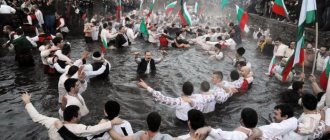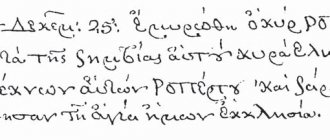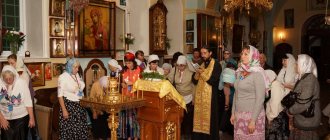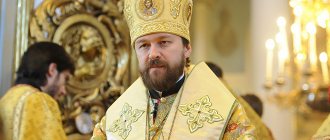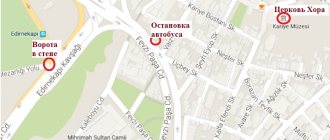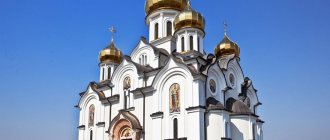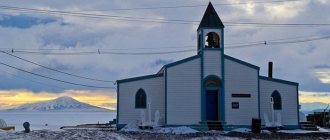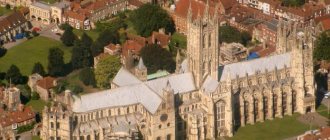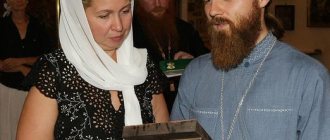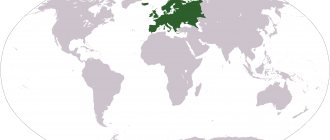Sinai - the heavenly mountain of the god Sin
Symbolically, “Mount Sinai” means the celestial sphere of the Moon, since Sin is one of the names of the Moon God among the Semitic peoples of antiquity. The Bible also contains “Mount Horeb,” which means the celestial sphere of the Sun, since Hor/Or/Ur/Ar is one of the names of the Sun god. It is in vain to look for these “mountains” on the surface of the Earth, for they are astral symbols, and nothing more.
The seven chapters of the book of Exodus that describe the Tabernacle are related to the number 7
, which in this case symbolizes the Moon.
This is how many days a seven-day lunar week lasts. Both Mount Sinai and the number 7
indicate that the description of the structure of the tabernacle was received from the planetary deity of the Moon. In astrology, planetary gods are called geniuses (from the Latin genius - spirit), and in Gnostic cosmology, archons (Greek boss, ruler).
Glorious picture of the building of the tabernacle Exodus 25:9
Before we talk about the design of the tabernacle of meeting, we must look at the material from which the tabernacle was built and the people who built it. The material for the construction of the tabernacle was, at the command of the Lord, donated by the people of God.
Let us listen to the command of the Lord regarding the material for the tabernacle. In Exodus 25:1-7 we read: “And the LORD spake unto Moses, saying, Tell the children of Israel that they should make offerings unto me; From every person who has zeal, accept an offering to Me. These are the offerings that you must accept from them: gold, and silver, and copper, and blue, purple, and scarlet wool, and fine linen, and goats, and red rams' skins, and blue skins, and shittim wood, oil for the lamp, spices. for the anointing oil and for the incense, the onyx stone and the set stones for the ephod and for the breastplate.”
And so the people of God began donating what was needed for the construction of the tabernacle. These were blessed days in the life of the Old Testament people of God. Extraordinary zeal gripped the entire people. And we read about this zeal in Exodus 36:3-7: “And they took from Moses all the offerings that the children of Israel brought for the needs of the sanctuary, to work. Meanwhile, they continued to bring voluntary gifts to him every morning. Then all the wise in heart, who carried out all the works of the sanctuary, came, each one according to his own work, and spoke to Moses, saying: The people bring much more than is needed for the work that the Lord commanded to be done. And Moses commanded, and it was declared in the camp, that neither man nor woman should do any more for the offering in the sanctuary; and the people stopped bringing. There was enough stock for all sorts of work that needed to be done, and there was even some left over.”
This is how zealous the people of God were in making sacrifices for the cause of the Lord! Doesn’t this remind us of the extraordinary zeal in the hearts of the Old Testament people of God for sacrifices for the Lord and His Kingdom of the first Christians, about which we read in the Book of the Acts of the Apostles?
But what a sad picture Old Testament Israel presented itself in the days of the prophet Malachi. This is the exact opposite of what we see in the days of Moses. Let us read about the fading zeal of the Israeli people, “sacrifices for the Lord in the Book of the prophet Malachi 1, 7-14: “You offer unclean bread on My altar and say: how do we dishonor You? ... and when you sacrifice blind things, is this not bad?” ? Or when you bring something that is lame and sick, isn’t that bad?”…
Let us watch our hearts so that the fire on his altar burns and does not go out (Lev. 6:12). Let's take the words of the apostle to heart. Paul in Romans 12:11: “Do not slack in your zeal.” Oh, how many children of the Lord are there who have weakened in zeal in serving their Savior and in whose hearts the fire does not burn, but only smolders!
Let us now look at the people who built the tabernacle of meeting in the days of Moses. We read in Exodus 31:1-6: “And the Lord spake to Moses, saying, Behold, I have appointed Bezaleel the son of Uri, the son of Hur, of the tribe of Judah; and I filled him with the Spirit of God, with wisdom, understanding, knowledge, and with all skill to work in gold, silver, and brass, to cut stones for setting, and to cut wood for every work. And behold, I have given him Aholiab the son of Ahisamach, of the tribe of Dan, as an assistant, and I will put wisdom in the heart of every wise man, that they may do everything that I have commanded you.” So, Beseliel and Aholiab were chosen by God Himself to lead the construction of the tabernacle. Bezalel was from the tribe of Judah, that is, the first tribe in the camp of Israel; Aholiab was from the tribe of Dan, that is, the last tribe in the camp of the people of Israel.
What does this tell us? That the Lord finds His servants from among people with different positions - both from the first and from the last; from those who occupy a high position in this world and from ordinary people; from the intelligentsia and from the most illiterate people. He needs hearts filled with the fire of zeal and zeal for the building of His Kingdom on earth. He needs the apostles Paul, who learned at the feet of Gamaliel, and the fishermen of Galilee. For them He has a work and a ministry. But what is surprising is that the Lord filled Bezalel and Aholiab with the Holy Spirit to fill such works for which today the Lord is hardly asked for power from above, the power of the Holy Spirit, namely for working in gold, silver or copper; for cutting stones or cutting wood. This is a great lesson for all of us believers, namely, to ask our Lord for power from above, the power of the Holy Spirit, even for the smallest service, for the most insignificant deed.
I now see before me thousands of our sisters in faith who are so burdened by their everyday unimpressive household chores, which turn their lives into a real routine, under which they often sigh. Which of these sighing sisters of ours would think of asking the Lord to be filled with the power of the Holy Spirit to carry out such invisible work? Meanwhile, it is precisely this day after day repeated and so monotonously performed work for the family that requires strength from above in order to carry it not only resignedly, but with love and joy.
The Word of God says that the tabernacle of meeting was built not only by Bezalel and Aholiab, but also by everyone whose heart was drawn to begin the work and to work. This is what it says in the Book of Exodus 36:2. Happy is the Church in which not only the prominent Veseliels and Aholiabs work, but also its most invisible and little-known members. Their service may seem as insignificant as two mites for a poor widow, but in the eyes of Christ, who sees our hearts, this service may turn out to be more successful than the service of prominent brothers or sisters. It is important that we carry out any of our service to the Lord “according to the desire of our hearts” as for the Lord Himself, and not for men (Col. 3:23). Then it will always be a blessed service.
The plan of the tabernacle was given by God Himself, both in its essential parts and in its minutest details. Let us read again the words of the Lord spoken to Moses: “All that I show you, both the pattern of the tabernacle and the pattern of all its vessels, shall you do so?” We see a lot of disobedience to the Lord in the history of the Old Testament people of God, but the commandment of the Lord regarding the tabernacle of meeting was fulfilled exactly as we read in the Book of Exodus 39, 42-43: “As the Lord commanded Moses, so the children of Israel did all these works . And Moses saw all the work, and behold they did it; as the Lord commanded, so they did.”
We, New Testament believers, have been given a most beautiful pattern for our lives, for our character, and for our ministry in the person of our Lord Jesus Christ. What about our imitation of Jesus Christ? His blessed life on our land is written before us on the pages of the Gospel. We know His character, full of meekness and humility. We also know His ministry, full of love for every person. We truly have the most wonderful example in Christ.
But why are we so little like Him? Our life, our character, our service to people are so far from the life, character and service of Christ. There is only one reason: we strive to imitate Christ! And without a thirst to be like Christ, we will not achieve His wonderful image. The task of all Christians in this world is to follow the example and pattern in Christ!
Structure of the Tabernacle
Let us now move on to a brief description of the Tabernacle. The tabernacle was to be located in accordance with the cardinal directions. The tent, 31x10 cubits, was located in the western part of the outer court. The distance from the curtains of the courtyard to the walls of the tent was 25 cubits from the north, south and west.
Structure of the Tabernacle.
The entrance to the Tabernacle was located on the eastern side, i.e. where the Sun rises, and was covered with a special canopy, with a total length of 20 cubits. The canopy was knitted from wool 3
colors: blue, purple and crimson.
Opposite the entrance, 5 pillars on the east side of the courtyard formed the gate of the Tabernacle. These pillars were covered with canopies of the same wool 3
colors. The gate curtains consisted of four parts, 5x5 cubits each.
Tent of the Tabernacle.
In the courtyard, opposite the entrance, there was a large square altar of burnt offering. Sacrifices were made on it, and a fire was constantly supposed to burn in it. In the very center of the courtyard there was a round washbasin for the priests. All courtyard accessories were made of copper.
The tent was a frame made of wooden planks overlaid with gold, covered 4
bedspreads made of various wools. It was divided into two parts by a curtain. The western part, measuring 10x10x10 cubits, was called the Holy of Holies (Kodesh Kodashim). In front of the Holy of Holies there was a space called the Holy Place (Kodesh), measuring 21x10x10 cubits, separated by a curtain from the front of the courtyard.
Thus, the tent consisted of three wooden walls: two side walls, to the north and south, and a back wall, to the west, and was closed with a curtain on the east side. Covers were thrown over the walls and top of the Tabernacle, giving it the appearance of a tent. There were four of them.
The Holy of Holies contained only the ark, the most holy item of the Tabernacle. The Sanctuary housed:
- the seven-branched candlestick - to the left of the entrance;
- table with 12 showbread - to the right of the entrance;
- the altar for burning incense is in the middle of the Sanctuary.
The High Priest before the veil in the Sanctuary.
Now let's look at the astral symbolism of the Tabernacle, starting with the courtyard.
Altar of Burnt Offering - Image of the Sun
So, in the courtyard of the Tabernacle, opposite the entrance and 22 cubits from it, there was a large square altar of burnt offering. At the top, at each corner, the altar had horn-like projections. An unquenchable fire was to burn on the altar.
In the history of various religious cults, in general, two types of altars can be distinguished:
- in the shape of a square;
- in the shape of a circle.
Square, cube, trapezoid, obelisk symbolize the number 4
.
In astrology, the number 4
is associated, firstly, with
the 4
lower elements of the Universe, and secondly, with the Sun.
The distance from the entrance to the altar of burnt offering of 22 cubits (2+2= 4 ) carries this numerical symbolism.
Read more about the solar symbolism of the quartet in the article Cross and swastika - symbols of the Sun. That is why the altar of burnt offering is square in shape, in which an unquenchable fire burns. The four corners with horn-like protrusions symbolize the astrological cardinal (main) cross of the Zodiac, the corners of which are at 4
signs representing
the 4
elements. Significant events related to the movement of the Sun across the Zodiac occur annually in these zodiac signs: 2 solstices - winter and summer and 2 equinoxes - spring and autumn.
Washbasin with water - image of the Moon
In front of the tent, behind the altar of burnt offering with an unquenchable fire, there was a round copper laver with water. It is not difficult to guess what symbolism this item of the Tabernacle carries. If a square fire altar symbolizes the Sun - the thermonuclear stove of the planetary system of the same name, then a round container filled with water should symbolize the Moon - the mistress of the water element in astrology.
In symbolism, a circle, semicircle, circle, column, bowl, well are associated with the feminine principle and water, which means fertility, birth, renewal, purification and the source of life. Note that it was impossible for the priest to enter the tent of the Tabernacle without first washing himself in the water of the round laver - the image of the night luminary of the Moon.
It was said above that in front of the entrance to the tent, and therefore between the round washbasin with water, there was a gate made of 5
pillars covered with a three-color canopy.
Here we see the same lunar symbolism. The numbers 5
and
3
are associated with the phases and periods of the Moon.
The number 5
is associated not only with the lunar phases, but also with
the 5
elements of the Universe. Read more about the five elements in the article The Five Elements of the Universe and their earthly correspondences.
Pentagram - a pentagonal star conveys symbolism well 5
main phases of the Moon and
5
elements of the Universe:
- new Moon;
- first quarter;
- full moon;
- third quarter;
- old moon
A number 3
symbolizes the three periods of the moon:
- Waxing Crescent;
- full moon;
- waning moon.
About the symbolism of numbers 5
You can also read in the article Symbolism of squares.
N 50 of the house 302 bis, and about the symbolism of the number 3
in the article Triple Goddess of the Moon.
Comparison results - 5 points
Tabernacle and Church - 5 Amazing Correspondences
TABERNACLE Ex. Ch. 40; Heb. 8:1-5
- Holy of Holies (Ex. 26:33-35)
- High Priest (Heb. 9:6,7)
- Cloth curtain (Ex. 26:31-37)
- Annual sacrifices (Heb. 10:1-4)
- Sanctuary (Ex. 26:31-37).
- The High Priest was responsible (Num. 18:1-7)
- The only way into the Holy of Holies (Heb. 6:19,20)
- The priests ministered in the sanctuary (Heb. 9:6,7)
- The outer court (Ex. 27:9-19). Accommodated the masses
- Sanctification of the Priests (Exodus ch. 29)
- Sacrifices on the brazen altar (Ex. 29:15-21)
- Rejection of the unsanctified (Lev. 21:1-8)
- Washing in the laver (Ex. 40:7; 40:15)
- Linen garments (Ex. 40:12-15; 39:1,2)
- Worship in the sanctuary (Heb. 9:6)
- Lamp (Ex. 40:4,24,25)
- Incense (Ex. 30:7-9)
- Showbread - weekly (Lev. 24:5-9)
- Daily sacrifices (Ex. 29:38-43)
CHURCH Ref. Ch. 40; Heb. 8:1-5
- Heaven itself (Heb. 9:8-24; Rev. 21:6)
- Christ (Heb. 9:11,12)
- His flesh (Heb. 6:19,20; 10:19,20)
- One sacrifice lasts forever (Heb. 10:10-20)
- Church (Heb. 10:16-22; 1 Tim. 3:15)
- Christ over the church (Heb. 10:21)
- Through the church is the way to heaven (Acts 2:47)
- Priesthood in the church (1 Pet. 2:5,9)
- Peace (John 3:17; 12:47; 17:16) In it are all people; the wicked (1 John 5:19)
- Conversion (Acts 3:19)
- Blood of Christ (Heb. 9:14,22; Rom. 3:24,25)
- Repentance (Luke 13:3)
- Baptism (Acts 22:16)
- Righteous Living (Rev. 19:8; James 1:27)
- Serving God in the Church (1 Pet. 2:5; 1 Tim. 3:15)
- Word of God (Ps. 119:105,130)
- Prayers (Ps. 140:2; Rev. 5:8)
- Taking the Lord's Supper weekly (Acts 20:7; Heb. 10:25)
- Our bodies (Rom. 12:1)
Tent Construction
Sectional view of the Tent of the Tabernacle.
Let us now move on to the symbolism of the tent structure. As already mentioned, the tent was covered with 4
covers made of various wool. Why four? According to classical astrology, between the Earth and the Moon, the first celestial sphere of the Universe, the lower elements/elements are located in the following order:
- Earth
- water
- air
- fire
The four elements were symbolized not only by the covers of the tent, but also by the curtains of the tent. Josephus, Jewish historian who lived in the 1st century AD. in his work Antiquities of the Jews (book 3, chapter 7), describing the Sanctuary, he wrote the following:
The curtains, woven from four types of material, serve as an emblem of the elements, with fine linen obviously reminiscent of the earth that gives birth to flax, purple - the sea, colored purple by the blood of fish, violet hyacinthos - azure air, and crimson serves as a symbol of fire.
And all the “floors”, i.e. The heavens of the Universe, starting from the celestial sphere of the Moon, are already filled with the fifth highest element - ether .
Content
- 1 Titles
- 2 The purpose of the Tabernacle and Temple in Judaism 2.1 The commandment for the construction of the Tabernacle and Temple
- 2.2 Opinions on the meaning of the Tabernacle and Temple
- 2.3 Functions of the Tabernacle
- 4.1 Location of the tent and courtyard
)
Sanctuary
The Holy Place (Kodesh) measuring 21x10x10 cubits is the front part of the tent, located immediately after the entrance to the tent from the courtyard of the Tabernacle. The sum of the numbers for the size of this room gives the number 5
(2+1+1+1).
Here the number 5
no longer means the number of main lunar phases, but the number of other celestial spheres located above the spheres of the Sun and Moon. After all, the symbols of the daylight (an altar with fire) and the night light (a laver with water) are located in the courtyard of the Tabernacle.
Unlike the visible altar and laver, the interior of the Sanctuary could only be seen by the priests. The symbols of the luminaries visible to all living on Earth - the Sun and the Moon - were visible, because were located in the courtyard of the Tabernacle. And the five planets located in the five heavens, symbolized by the space of the Sanctuary, were and are not observed by all inhabitants of the Earth.
It’s not that these wandering stars are not visible from the Earth (they are visible to the naked eye), but in order to see them and even observe them, certain knowledge was needed, which only priest-astrologers could have, i.e. priests. And in order to see the Sun and Moon you don’t need to have any knowledge at all. Even representatives of the animal world see them.
The seven-branched candlestick is a symbol of the septenary
Josephus, in the 6th chapter of the same volume, describing the seven-branched candlestick, wrote the following:
Opposite this table, closer to the southern wall, a golden lamp of chased work was placed... It consisted of round tubes, spherical lilies, images of pomegranates and cups, up to seventy in number, which all emanated from one common base and rose upward, forming such a number of branches , how many planets exist together with the sun, exactly seven cups located in one line (at the same height) opposite each other. These cups held seven light bulbs, also corresponding to the number of planets.
And in the 7th chapter of the same volume he wrote:
The lamp, consisting of seventy component parts, resembles the signs through which the planets pass, and the seven lights on it indicate the course of the planets, of which there are also seven.
So, there are two luminaries: day and night, the symbols of which are in the courtyard of the Tabernacle. There are also five planets, the numerical symbolism of which is present in the dimensions of the room called the Holy (Kodesh). Together they form the septenary known in astrology. The term “septenary” in classical astrology refers to the seven wandering stars (planets): the Moon, the Sun, Mercury, Venus, Mars, Jupiter and Saturn.
The seven-branched manorah (menorah) located in the Sanctuary was precisely intended to symbolize the astrological septenary - 7
planets.
As you know, the seven-branched candlestick was supposed to have 7
branches ending in
7
lamps. Each of the lamps symbolizes one of the wandering stars of our planetary system, including the central star - the Sun.
12 loaves - a symbol of the Zodiac
Opposite the seven-branched candlestick there should be a table on which there would be 12 loaves, arranged in two rows, and, most likely, in two stacks. 12 loaves , and even divided into two parts? Astrologers will understand why. For those who are not familiar with astrology, I will explain.
Reconstruction of Showbread.
The Zodiac is a belt extending 8 degrees on either side of the ecliptic, within which the visible movement of seven wandering stars (planets) occurs. The zodiac is divided into 12 equal 30 degree segments called signs. Thus, the 12 loaves symbolize the twelve signs of the Zodiac, which in turn make up the 12 months of the solar year.
In the same Antiquities of the Jews (book 3, chapter 7) Josephus wrote:
The twelve loaves of bread lying on the table represent the year, divided into the same number of months.
On the south side of the tent there is a seven-branched candlestick, and on the north there are 12 loaves. The south symbolizes the bottom, and the north symbolizes the top. Symbolically 7
wandering stars are located under the zodiac circle, which is located above them.
On the table, 12 loaves are divided into two parts, because the 12 zodiac signs are also divided into two parts - day and night.
The six signs located on the side of the Leo sign are called day signs, and the six signs located on the side of the Crab sign are called night signs. Why were these two signs chosen, dividing all signs into two parts? The sign of Leo is the astrological house of the day luminary - the Sun, and the sign of Crab is the house of the night luminary - the Moon.
Holy of holies
The tent consisted of two spaces (the Holy and the Holy of Holies), separated from each other by a special curtain, through which not just a priest, but a high priest could enter once a year. The curtain dividing the entire tent into two parts was supposed to symbolize the 8th sphere of the Universe - the Firmament (lat. Firmamentum), or the sphere of the fixed stars. It is with the eighth sphere, or heaven, that the numerical symbolism of male circumcision on the 8th day is associated.
The highest heavens of the Universe
If the dimensions of the Sanctuary (21x10x10 cubits) symbolize the number 5
planetary spheres located below the sphere of the fixed stars, then the Holy of Holies symbolizes
the 3
highest celestial spheres of the Universe:
8th sphere – Firmament (lat. Firmamentum); 9th sphere – Crystal (lat. Crystallinum); 10th sphere – Empyrean (lat. Empyreus).
The dimensions of the Holy of Holies were to be 10x10x10 cubits. The dimensions of this space (1+1+1=3) are not associated here with lunar symbolism. Here the trinity is associated with the three highest heavens of the Universe.
In Kabbalah, the mystical teaching of Judaism, there is such a fundamental concept as the Tree of Sephiroth, consisting of ten sephira. The word "sefira" comes from the Greek word "sphere". Spheres in astrology are the heavens of the Universe, of which there are ten in number, just like the sephira in Kabbalah. Therefore, the Tree of Sephiroth is another picture of the structure of the Universe.
By the way, the word Kabbalah has the same source of origin as the word Kaaba. Read about the origin of the word “Kaaba” in the article The Arab Trinity of Moon Goddesses.
The word “tabernacle” is translated from ancient Greek as “tent, tent,” because the mobile Tabernacle was not intended for a sedentary way of life. Therefore, the tent of the Tabernacle is a horizontal model of the Universe, consisting of
4 elements of the Sublunary world; 7 Middle Heavens; 3 Highest skies.
If the horizontal model of the Universe is transformed into a vertical one, i.e. stationary, then it would look like a Hellenic temple with seven columns.
Shekinah - Chokmah - Sophia
The highest heaven is the Empyrean, the tenth Heaven, where the Shekinah resides. Who is Shekinah (Heb. Presence)? Jewish Gnostics called it Chokmah (Hebrew: Wisdom), known among Hellenic Gnostics as Sophia (Greek: Wisdom). On behalf of Wisdom in the biblical Book of Proverbs (8:22-31) the following is written:
The Lord had me as the beginning of His path, before His creatures, from time immemorial; I have been anointed from everlasting, from the beginning, before the existence of the earth. I was born when there were no deeps yet, when there were no springs abundant with water. I was born before the mountains were erected, before the hills, when He had not yet created either the earth, or the fields, or the initial specks of dust of the universe.
When He prepared heaven, I was there. When He drew a circular line across the face of the abyss, when He established the clouds at the top, when He strengthened the sources of the abyss, when He gave the sea a charter so that the waters would not cross its borders, when He laid the foundations of the earth: then I was an artist with Him, and I was a joy every day, having fun before His face all the time, rejoicing in His earthly circle, and my joy was with the sons of men.
So to whom was the Tabernacle dedicated, being a model of the Universe? In Hebrew, both the Holy Place (Kodesh) and the Holy of Holies (Kodesh kodashim) are derived from the word “kodesh.” Kadesh, or Kodesh and Kedesh, is an epithet with the meaning Holy, which belonged to Asherah, widely known in ancient times, also known as Astarte-Anat. In ancient times, on the territory of modern Syria, there even existed the state of Kadesh, as well as the city of Kadesh in honor of this Goddess.
The goddess Kadesh was depicted standing on a lion with a snake in one hand and a lotus flower in the other hand - symbols of world creation. She was called the “Lady of all gods” and “Heavenly Lady of the Stars.” The crescent moon and sun disk on her head connects her with the ancient Egyptian goddess Hathor. The Egyptians also called Hathor the “Queen of Heaven” and the “Lady of Heaven.”
Goddess Kadesh - “Lady of all gods” and “Heavenly mistress of the stars.”
The Kodesh Kodashim - the Holy of Holies - was supposed to contain only one item - the Ark of the Covenant. The ark was a portable box or casket. What did this casket symbolize and what was in it?
Ark - casket of the Great Goddess
To answer this question, you first need to find out what symbolism such objects as a box, casket, or chest carry. These closed objects, which can be opened when needed, symbolize the feminine principle and the mother's womb. In J. Cooper's encyclopedia of symbols we read:
The box represents the feminine principle of containment, imprisonment, womb.
In Ancient Egypt and Canaan, there was also a casket or ark that was carried by priests.
Casket (ark) and the ancient Egyptian goddess Maat.
The ark carried by the priests contained the djed . In the pre-dynastic period of Ancient Egypt, the djed was a wooden pole to which ears of wheat were tied with a ribbon.
Left: Egyptian priests carrying the ark. Right: didukh - a variant of djed.
The ancient Egyptian djed resembles the didukh of the Slavs. Anyone who has seen the didukh will also imagine the djed. Even their names are similar. Both didukh and djed are symbols of male fertility, because symbolize the masculine principle.
Titles[edit]
The Bible uses two naming systems to designate the Tabernacle:
- one is based on the name mishkan
(“המשכן” - “abode”, “abode” [of God]), and includes
mishkan ha-edut
(“משכן העדות” - “dwelling place of the testimony,” that is, the Tablets of the Covenant, which were in the Ark of the Covenant) and
Mishkan Hashem
(“משכן ה” - “the seat of God”), that is, the place where the Shekinah of the Creator resides on earth, among the people of Israel; - the other is based on the name ohel
(“אוהל” - “tent”, “tabernacle”), and includes
ohel moed
(“אוהל מועד” - “tabernacle of meeting” or “tabernacle of testimony”), and
ohel ha-edut
(“אוהל העדות” - “tent of testimony”).
Several places in the Bible combine both names into one mishkan ohel moed
(“the seat of the tabernacle of meeting”)[1].
This is explained by the fact that both of these words are mishkan
and
ohel
are synonyms in Hebrew[2].
Much less often in the Bible you can find other names for the Tabernacle: mikdash
(“Sanctuary”) and
ha-kodesh
(“holy place”), that is, a place that concentrates holiness.
